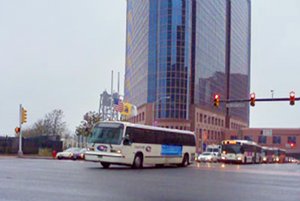 In addition to hosting an extensive commuter rail and light rail system, northern New Jersey is served by a vast network of local and commuter bus routes that connect people to jobs, recreation, and services across the region. Approximately 50 of these bus routes, operated by NJ TRANSIT and Coach USA, converge in the City of Newark, making it a critical hub for people transfering between buses, as well as between bus and rail.
In addition to hosting an extensive commuter rail and light rail system, northern New Jersey is served by a vast network of local and commuter bus routes that connect people to jobs, recreation, and services across the region. Approximately 50 of these bus routes, operated by NJ TRANSIT and Coach USA, converge in the City of Newark, making it a critical hub for people transfering between buses, as well as between bus and rail.
The Greater Newark Bus System Study, jointly funded by the NJTPA and NJ Transit, was completed in summer 2011 and recommends improvements to bus services and intermodal transit connections in the greater Newark area. The study focuses primarily on the core service areas of downtown Newark (including connections to rail services at Newark's Penn Station and Broad Street Station), suburban Essex County, Newark Liberty International Airport, and the City of Elizabeth in neighboring Union County. Bus service improvements in these areas will positively impact service in Union, Passaic, Bergen and Hudson counties as well. Consultant services were provided by a team led by the Abrams-Cherwany Group of Gannett Fleming, Inc.
 The study developed a comprehensive package of short, medium and long-term recommendations to improve reliability and provide needed service to existing and potential new bus riding customers. These include:
The study developed a comprehensive package of short, medium and long-term recommendations to improve reliability and provide needed service to existing and potential new bus riding customers. These include:
-
New and restructured routes to better serve work and non-work travel needs
-
Improved access to Newark Liberty International Airport and Port Newark-Elizabeth
-
New "go bus" Bus Rapid Transit (BRT) options to increase bus speed and relability
-
Multi-modal transit hubs for better connectivity between bus and rail modes
Some proposals, such as the first phase of the speedier "go bus 28" route between Bloomfield, Newark and the Airport, and a bus-only "queue-jump" lane with dedicated signals on Raymond Boulevard by Newark Penn Station (pictured above), were early action" recommendations implemented during the course of the study.
The Final Report describes the study process, overall goals of the service improvement proposals, and identification of priority recommendations from among the extensive list of proposed changes.